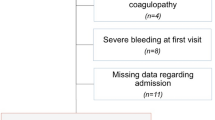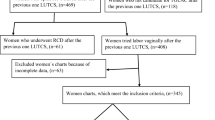Abstract
Objective:
To evaluate whether second trimester pregnancy termination with dilation and evacuation (D&E) vs induction of labor (IOL) affects subsequent risk of preterm birth.
Study Design:
Our cohort was a retrospective cohort of women undergoing second trimester pregnancy termination for fetal anomalies, fetal death or previable premature rupture of membranes. We analyzed the rates of spontaneous delivery <37 weeks in the first pregnancy following the termination. We also compared preterm birth rates in our cohort with national averages and analyzed by the total number of prior procedures.
Result:
There were 173 women in our cohort. Women who had undergone a D&E (n=130) were less likely to have a subsequent preterm birth (6.9 vs 30.2%; P<0.01). This held true for a low risk subset without obstetric risk factors. There was no statistical difference in preterm birth rates for women who had undergone a D&E as compared with national averages, nor between the rates of preterm birth for women with 0, 1, 2 or 3 or more prior first or second trimester procedures.
Conclusion:
We did not find that D&E was a risk factor for preterm delivery when compared with women with a prior IOL or national rates.
This is a preview of subscription content, access via your institution
Access options
Subscribe to this journal
Receive 12 print issues and online access
$259.00 per year
only $21.58 per issue
Buy this article
- Purchase on Springer Link
- Instant access to full article PDF
Prices may be subject to local taxes which are calculated during checkout


Similar content being viewed by others
References
Guttmacher Institute. Induced Abortion in the United States, July 2014. Available at: <http://www.guttmacher.org/pubs/fb_induced_abortion.html> (accessed on 3 May 2015).
American College of Obstetricians and Gynecologists. ACOG Practice Bulletin No. 135: Second-trimester abortion. Obstet Gynecol 2013; 121: 1394–1406.
Shah PS, Zao J ; Knowledge Synthesis Group of Determinants of preterm/LBW births. Induced termination of pregnancy and low birthweight and preterm birth: a systematic review and meta-analyses. BJOG 2009; 116 (11): 1425–1442.
Kalish RB, Chasen ST, Rosenzweig LB, Rashbaum WK, Chervenak FA . Impact of midtrimester dilation and evacuation on subsequent pregnancy outcome. Am J Obstet Gynecol 2002; 187 (4): 882–885.
Jackson JE, Grobman WA, Haney E, Casele H . Mid-trimester dilation and evacuation with laminaria does not increase the risk for severe subsequent pregnancy complications. Int J Gynaecol Obstet 2007; 96 (1): 12–15.
Schneider D, Halperin R, Langer R, Caspi E, Bukovsky I . Abortion at 18–22 weeks by laminaria dilation and evacuation. Obstet Gynecol 1996; 88 (3): 412–414.
Chasen ST, Kalish RB, Gupta M, Kaufman J, Chervenak FA . Obstetric outcomes after surgical abortion at>or=20 weeks gestation. Am J Obstet Gynecol 2005; 193 (3 Pt 2): 1161–1164.
Ancel PY, Lelong N, Papiernik P, Saurel-Cubizolles MJ, Kaminski M ; EUROPOP. History of induced abortion as a risk factor for preterm birth in European countries: Results of the EUROPOP survey. Hum Reprod 2004; 19 (3): 734–740.
Henriet L, Kaminski M . Impact of induced abortions on subsequent pregnancy outcome: the 1995 French national perinatal survey. BJOG 2001; 108: 1036–1042.
Zhou W, Sorgensen HT, Olsen J . Inducted abortion and the subsequent pregnancy duration. Obstet Gynecol 1999; 94 (6): 948–953.
Mirmilstein V, Rowlands S, King JF . Outcomes for subsequent pregnancy in women who have undergone misoprostol mid-trimester termination of pregnancy. Aust N Z J Obstet Gynaecol 2009; 49 (2): 195–197.
Winer N, Resche-Rigon M, Morin C, Ville Y, Rozenberg P . Is induced abortion with misoprostol a risk factor for late abortion or preterm delivery in subsequent pregnancies? Eur J Obstet Gynecol Reprod Biol 2009; 145 (1): 53–56.
Acknowledgements
These data were presented at the 35th Annual Scientific Meeting of the Society for Maternal Fetal Medicine, 2 to 7 February 2015, San Diego, CA, USA. Financial support was provided for this project in the form of department funds.
Author information
Authors and Affiliations
Corresponding author
Ethics declarations
Competing interests
The authors declare no conflict of interest.
Rights and permissions
About this article
Cite this article
Little, S., Janiak, E., Bartz, D. et al. Second trimester dilation and evacuation: a risk factor for preterm birth?. J Perinatol 35, 1006–1010 (2015). https://doi.org/10.1038/jp.2015.132
Received:
Revised:
Accepted:
Published:
Issue Date:
DOI: https://doi.org/10.1038/jp.2015.132
This article is cited by
-
Subgroup identification of early preterm birth (ePTB): informing a future prospective enrichment clinical trial design
BMC Pregnancy and Childbirth (2017)



